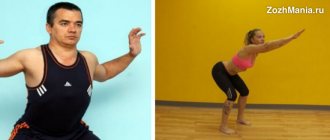Rhythmic gymnastics is a professional sport that involves performing various exercises with elements of gymnastics and dance, accompanied by music. To perform exercises in rhythmic gymnastics, objects such as jump ropes, hoops, balls, clubs and colorful ribbons can be used. By custom, it is considered a women's sport.
The performance of rhythmic gymnasts always resembles a staged show. Firstly, an appropriate musical composition is selected for the exercises. Secondly, all exercises are performed to the rhythm of music, which is reminiscent of a dance performance. Thirdly, the flexibility, dexterity and grace with which the gymnasts soar on stage captivates and captivates until the last second of the performance.
As a rule, girls are sent to the rhythmic gymnastics section. Vocational schools accept children from the age of five. Little girls have good stretching and flexibility, but with age, unfortunately, it gradually deteriorates. The good news is that even as an adult, you can easily regain your former muscle tension with constant training.
Behind all the beauty and charm of the gymnasts' performances, there is hidden the daily and long hours of work in the gym.
Rhythmic gymnastics classes for adults are aimed at developing flexibility, plasticity and coordination in women. They help develop the maximum possible muscle stretch, giving grace and harmony to the body. Remember how majestically the girls step onto the carpet, with what grace and coquetry they perform complex elements of the program. Coaches teach girls in the rhythmic gymnastics section for adults all these basic basics of performance. After all, the main thing in sports is “the ability to present oneself.”
Rhythmic gymnastics exercises: why should adults do them?
First of all, it's beautiful. Secondly, it is very useful. “Rhythmic gymnastics classes help develop flexibility, plasticity, and coordination,” comments Kristina Radikevich , master of sports in rhythmic gymnastics;
champion of Russia, multiple champion of Moscow and international tournaments and expert of the company “Gracia&Sport”. “They also improve posture and foot health, which has a positive impact on overall physical health.” Therefore, even if you don’t fancy yourself the new Alina Kabaeva, it’s still worth a try - at least to improve your well-being, posture and figure.
Parents counted the pros and cons of rhythmic gymnastics
In September, it is customary to send children to sports sections and additional education centers. At the same time, parents, inspired by the all-round development of the child, do not always understand the level of expenditure - effort, time and money - that this or that type of activity will require. Let's bring those who dream and see their girl in the beautiful role of a rhythmic gymnast up to date.
Anastasia Rudik shares the pros and cons of practicing this sport with the shopping.altapress.ru audience . Her daughter has been passionately involved in gymnastics for the sixth year, and last season she received her first adult rank. As Anastasia says, “we don’t regret one bit that rhythmic gymnastics is in our lives.”
"+" Early start
The ideal age for starting rhythmic gymnastics is from 4 to 6 years, when children’s ligaments and joints are still very mobile and can easily tolerate the forced stretching necessary for this sport. In addition, gymnastics is not as dangerous as many other sports, and therefore is allowed for young children.
"-" Complaints
Parents should be prepared for the fact that the child will get tired, complain of lethargy, pain in the back and legs. Over time, complaints may decrease, depending on the character and endurance of the individual child.
For girls who were sent to gymnastics very early, stretching comes easily.
excalibur-center.ru
“+” Physical development
Doctors believe that rhythmic gymnastics classes in the initial stages are beneficial for a young body: basic exercises form a muscle corset and correct posture, develop dexterity and coordination. The child grows flexible, strong, and resilient.
“-” Where it’s thin, that’s where it breaks
The back, knees and ankles suffer the most from high loads among rhythmic gymnasts. The child may need specialized help - massages, pain-relieving applications, so that the body can cope with physical stress.
Rhythmic gymnastics is not as dangerous as sports gymnastics, but the snake-like flexibility of female athletes often provokes back pain.
i.ytimg.com
“+” Grace and musicality
Rhythmic gymnastics is one of the most vibrant and feminine sports. From the first lessons, girls are taught to feel melody and rhythm, and to move beautifully. Their flexibility and polished movements during their performances evoke an incredible response from the viewer! After some time, the gymnast can be distinguished among her peers by her excellent posture, chiseled figure and special grace.
"-" Haute couture equipment
Leotards and objects (balls, hoops, clubs, jump ropes) for performances need to be professional - spectacular and of high quality, and therefore very expensive.
Swimsuits are made from special fabrics, with intricate patterns of rhinestones, pearls and hand-painting. A suit with a “decent” finish requires more than 2 thousand Swarovski crystals (simple “glasses” are not included): the more glitter, the better the swimsuit looks during the entrance. Materials for costumes are purchased for euros. Only a few seamstresses have the technology for modeling and sewing them; you won’t go to a studio with this order.
Non-professional hoops are not suitable for performances, as they are very fragile and can break at any time.
mgfso.ru
“+” Self-control and emancipation
Classes in crowded groups, endless performances side by side with unfamiliar opponents in front of very different audiences socially adapt the child, forming a more stable psyche than his peers. Parents do not have to worry that he will be shy or scared in an unfamiliar environment.
"-" Price tag for skill
A gymnast can present to the world and confirm her successes and skills only at competitions that take place quite often. In most cases, these are commercial tournaments (not financed from the regional budget), which requires participants to pay an entry fee - from a thousand rubles.
Participation in away tournaments is highly desirable, and at least four times a year. Coaches there notice new trends, children follow stronger opponents and earn the points necessary to receive a rank. It’s good if an away tournament takes place in the region or neighboring regions, but they also invite you to the European part of the country! Naturally, parents pay for their own travel, accommodation and food. In some cases - not only your child, but also part of the coach’s trip, if the sports school does not pay for him.
Even a young gymnast knows how to “present” herself to the public - this sport is akin to acting.
city-68.com
“+” Strong character
It is unlikely that anyone will begin to dispute the fact that a child, accustomed to work and discipline from childhood, grows up to be a strong personality. Of course, any sport builds willpower and patience. But in gymnastics there are cases when diligence helps to “shoot” even for those who were not particularly successful in the first years of training or started training late.
Let's say, the current vice-president of the All-Russian Federation of Rhythmic Gymnastics, Evgenia Kanaeva, was brought to the gymnastics section by her grandmother at the age of 9 with the wording “we should straighten our legs.” The girl was very clubfooted, but after working out, she won everything she could in big-time sports, becoming a multiple champion of Europe, the world and the Olympic Games.
“-” Heavy workload = falling behind in school
Training for young children takes place 3 times a week and lasts 1-1.5 hours. For older students, study hours are doubled. If parents are committed to professional sports - performances in competitions and winning prizes - then there should be a lot of training and they will be long.
At the very beginning of the sports journey, the child will sincerely try to do well both at school and in the section. But, most likely, estimates will slowly and surely decline. Parents will have to help their child with lessons for which he simply will not have time and energy.
As they grow older, the workload of gymnasts increases and, as a rule, they do not have enough time to prepare for lessons properly.
vk.com/club86763591
“+” Classes for yourself
Professional sports are not the only option. Not everyone can strive for Olympic heights - you can also train “for general development.” Today, in many gymnastics schools there are health groups that accept quite adult children - up to 9 years old. Girls exercise in their free time, getting good physical training, developing grace and a sense of rhythm, keeping themselves in good shape.
"-" Equality with others
Even if parents do not set a goal to raise their daughter to be a champion in rhythmic gymnastics, she may seem “worse than others” if she does not go to training camps during the holidays. In some sports schools, such trips to a sanatorium (recreation center/training complex) are practiced several times a year, in others - only in the summer. The training regime - daily multi-hour training - significantly increases the level of gymnasts' skills, but also requires serious expenses from parents.
In some sports schools, it is customary to conduct training camps abroad, which requires parents of gymnasts to have an appropriate financial level.
mgfso.ru
“+” Temptations on the side
Bad company and bad habits, as a rule, bypass those who are passionate about sports. Gymnasts simply don’t have time to wander aimlessly along the street, look for adventures on their own, or indulge in energy drinks or alcohol.
“-” Without sleep and rest
While other children usually have a variety of leisure activities on the weekend, the young gymnast is training or performing. Her summer holidays cannot last longer than a month, otherwise the acquired shape, flexibility and stretching will go down the drain. And since the mission of maintaining a fairly strict regime falls on the parents, they must withstand it first of all themselves and literally “live” through rhythmic gymnastics. Otherwise there will be no point.
With all the restrictions and stress that girls experience in gymnastics, they fall in love with this sport.
f2.s.qip.ru
How much does it cost*
- Training uniform (T-shirt-shorts/leggings) - from 800 / 1.2 thousand**
- Working shoes: half shoes - from 200/1.4 thousand, pointe shoes included - 2.7 thousand.
- Team tracksuit - from 1.8 thousand.
- Professional equipment***:
— hoop — 1.3 thousand,
— ball — 1.8-4.4 thousand,
— jump rope — 1.1−3.2 thousand,
— clubs — 1.9−4.7 thousand.
— tape included — 800−4.4 thousand.
Gymnastic balls are a capricious thing. They pumped it up carelessly, carried it into the cold without a cover - and now the expensive ball is deflating.
vk.com/club86763591
- Swimsuit****:
- used - from 5 thousand (plus the cost of fitting to the figure and re-gluing fallen rhinestones),
— new for beginners/group — from 15 thousand,
- new for older people - from 25-40 thousand,
- Additional classes with a choreographer or guest trainer - from 600/hour
- Rent of a commercial hall - from 1.5 thousand/month.
- Away tournament - from 7.5 thousand / Novosibirsk: 3 days (travel, accommodation, meals).
- Departure for training camp
— in the vicinity of Barnaul — from 15 thousand / 3 weeks
— to Kazan — 23 thousand/week (without flights),
— to Kaliningrad — from 50 thousand/10 days,
— abroad — from 100 thousand.
*Average prices are indicated in rubles. Valid at the time of preparation of the material.
**Requires regular replacement. Due to intense training, the uniform quickly wears out to holes, and is periodically lost during training camps and competitions.
*** Beginners can buy non-professional equipment, but working with “analogues” is difficult: the hoops are deformed, the balls do not have the required weight and surface. So it’s better to learn from the good stuff right away. At the same time, you can “grow out” of a hoop or jump rope already in the first year, and gymnastic balls easily become unusable from careless handling.
**** Senior gymnasts are usually given two leotards for single performances, and if they are also involved in group routines, then three suits. Taking into account the growth rate of the child and the obsolescence of the design of the model, it is necessary to sew a new swimsuit on average every 1.5-2 years.
In Barnaul you can count on one hand the number of craftswomen who develop original styles of leotards for gymnasts.
vk.com/club86763591
How do rhythmic gymnastics training work?
Gymnastics lessons for adults are generally similar to what is done in classes in children's groups. “The training includes elements of fitness, stretching, and dancing,” explains Kristina Radikevich. “For example, at each lesson, special exercises are performed to develop flexibility and stretching, to set and correct posture, feet, to strengthen the abs, leg and back muscles. The training also includes mastering elements with a ball, mace, ribbon, jumps, turns, and acrobatic movements.”
If you have never done rhythmic gymnastics before, and in general you are not very familiar with sports, you should first master all these exercises with a trainer in the gym. But you can try to hone some basic elements, such as stretching and foot exercises, at home. This will help you understand whether you like this kind of training. In addition, even these simple exercises will be enough to improve stretching, relax the back muscles, and develop flexibility.
We asked Kristina Radikevich to compose and show us a set of rhythmic gymnastics exercises for adults.
Some more tips for parents:
* If you want to send a girl to do rhythmic gymnastics, look for a coach who will not break the child’s psyche and develop an inferiority complex in her charges.
* Support young gymnasts, help them not to lose faith in themselves, do not allow coaches to insult children (unfortunately, many of them are guilty of this). Trust your daughters, and if they constantly complain about the coach, think about switching to another specialist. Yelling and abuse can seriously ruin a child's life.
* Do not expect that the girl will necessarily have a wonderful figure; if this is not genetically inherent, then gymnastics will not help. You can develop good posture and the ability to move beautifully, but you cannot change what is inherent in nature.
* Teach girls to lose with dignity, not to consider losing the end of the world, and to respect their rivals.
* Be prepared to work hard yourself, gymnastics will enter the life of the family and begin to dictate its terms, and you will have to adapt.
* Closely monitor the health of your children and, at the slightest warning sign, consult a doctor to prevent the development of serious consequences.
Nevertheless, despite the difficulties, many parents of young gymnasts are pleased that they chose this particular sport for their daughters, and unanimously say: it is better to try and leave if “it doesn’t work” than not to try and then regret it.
How to build a lesson
* Start your workout with a warm-up. 4-5 minutes of joint exercises will help warm up the ligaments. Then perform 100 jumping rope jumps: 50 by rotating the rope forward, 50 by rotating it backward.
* Do the exercises consistently.
* Don't chase speed: there are a lot of stretching exercises in the complex, they cannot be performed in jerks. “Try to relax and make an effort as you exhale,” Christina reminds.
* Focus on your feelings. Mild muscle discomfort is acceptable, but sharp pain is not. The first indicates that the muscles are gradually stretching, the second can signal an injury.
* Do this program 5-6 times a week. “Regularity is very important when it comes to developing flexibility: the more often you do the exercises, the faster you will achieve results,” says Kristina Radikevich.
To perform the exercises of the complex you will need a mat and a jump rope.
Ready to start class? Repeat after Christina.
Fluttering “on the curtains”: everyday life, training and victories of young aerialists
Black Bird Fest recently took place in Moscow. This is a competition for athletes who have devoted themselves to aerial gymnastics, pole dancing and dance performance. Let’s focus on the first of the three areas, because the Vladimir team showed 12 programs, and eight (!) won awards. Why not watch how young talents train and chat with their charming coach Kristina Sapilova?
— Kristina, you gave an interview to Key-Media a couple of years ago.
But then they performed in the role of tightrope walkers .
Are you continuing your own sports career? - Yes. Of course, due to quarantine, I haven’t been able to take part in competitions for a long time. But I don't even think about stopping.
— How long ago did you try yourself as a coach?
— It all started in 2017, then I trained only with adults. And at the end of 2021, the first girl students came to me. First just one, then three more. And, frankly, at that moment I thought that this was quite enough. But somehow gradually our team grew to about 40 people. All the girls are of different ages: there are kids 6-8 years old, there are teenagers 13-15 years old, there are even older ones. Well, the adult group, on the contrary, has become smaller in number. So, of course, priorities shifted a little.
— How does the work of an athlete differ from the work of a coach?
— As I regularly say at competitions, it would be better if I performed 20 programs myself than stood alone, looking at the girls. This is a colossal emotional burden. When they perform, it feels like you're running a marathon or something like that. Difficult! And in terms of working with them, it’s more interesting than you are alone in the hall. By training, I reach new levels and recharge with energy.
— You just recently returned from competitions. I had to spend a lot of nerve cells, but it was not in vain - we brought home awards, titles... Tell us more, please.
— These competitions are far from the first of the season. But after quarantine, everyone was rocking for a very long time. And finally, we were able to go as a large team and present 12 programs to the jury at once. It was an all-Russian tournament, an art festival. The event was very significant: there were a huge number of athletes, representatives from almost all regions of Russia. Moreover, in each of the nominations 10-20 participants competed for victory at once. But when I just started playing this sport, there might have been no competition at all in children’s categories. At most, three young athletes brought their programs. You can see how the sport is gaining momentum. Now “our” competitions are quite comparable in scope to rhythmic gymnastics.
— 12 programs is a huge amount of work. Did you create them specifically for the art festival? How long did it take you to prepare?
— We adapted these programs to the performance. Previously they performed in Vladimir at the Snow Gate competition. For the first time, by the way, the competition was held in our city. We collaborated with the international federation, whose representatives came to us from St. Petersburg. The organizers celebrated our girls and promised to come to us again.
First of all, the program depends on the type of hangers used on site. In the Art Hall, where the competition took place, the systems were made similar to what you see in this hall - everything was attached to cables. And in Vladimir we performed a regular program, where the emphasis is on performing certain elements, like in sports. For an art festival, each image was thought out more carefully - at such events, the element of entertainment and show is important. Let’s say Veronika Tarasova performed with the program “Failed Experience.” I went on stage in a white robe, arranging the cones. A few beautiful waves of a scarf made of gray tulle, and it seems to the audience that the chemist’s experiment did not go according to plan, smoke poured out. And Veronica gets up from it. This find was noted by the circus choreographer from the jury. He praised her for her originality. Alas, out of 16 participants in this category, we took only 4th place. Still, the program was new, literally one point was missing from the “bronze”.
— You drew an interesting parallel with rhythmic gymnastics. This is an Olympic sport. Is there a chance for aerial gymnastics to reach the same level? And beyond the Games, are there horizons for growth?
— Firstly, circus festivals - we are already actively performing in the arena, or rather, under the dome. For example, I went to Estonia precisely to participate in such an event. My student, Lena, talks about championships quite often. I think it is possible that in a few years we will see some of the girls in the circus arena. And you shouldn’t forget about the sports path. What can I say, pole dancing is now a pre-Olympic sport. I believe that we deserve no less attention.
— Have you personally had any thoughts of building a circus career?
— To be honest, I’m now getting a completely different specialty - I’m studying at a university in the direction of “Pedagogy and psychology of deviant behavior.” And I don’t know how life can turn out. “In the future” I will receive a diploma of higher education. However, now I feel comfortable as a coach. But there are still stereotypes among the people that sometimes hurt. “Is being a gymnast or a coach really a profession? Here is the same psychologist, teacher - this is solid. How is it that you, an excellent student, are suddenly coaching?!” But I hope that society will soon change its attitude.
After all, coaches have no less impact on students than teachers in schools. They share secrets with us, ask for advice, and trust us. We are educators too. Doing aerial gymnastics is not “climbing ropes”, it’s much deeper! This is where character is formed. Girls overcome their fears and barriers. Just the other day there was an incident. A few years ago, one of my students fell while playing somewhere on the horizontal bar and broke her arm. Suddenly, during training, the pain and fear of that situation came back to me. The baby cried and got scared again. My knowledge of psychology helped here. We hugged, talked about that story, returned to classes - the tears were gone.
— Is there a difference in working with children and adults? What is she wearing?
— For adults, aerial gymnastics is one of the areas of fitness. They come to keep fit. Children need championships and prospects. You can be stricter with them.
— Do you often have to be harsh?
- Occasionally. I once saw chocolates before training. And this is at 8 pm, right before class! Simply explaining that it is harmful to health seemed ineffective to me. Therefore, instead of working on apparatus, we spent all the time on general physical training - more boring, but also useful. And I immediately remembered why you shouldn’t eat sweets in the evening before training. I didn't see any more chocolates.
But usually I don’t even raise my voice to them. Only if it is physically necessary: it’s noisy, the music is playing, but you have to finish shouting. But this is not swearing in a raised voice. Such methods have not worked with young people for a long time. Children are different now. This was strictly possible with us. Not with them. They will also give me a head start on some issues, enlighten me on new trends like TikTok, and tell me about trends (laughs). They have more access to information than we once had, which means they are smarter. We have our own positions, opinions - all this must be taken into account. You can't achieve anything by stomping your feet or banging a pointer on the table. Just talk.
— Championships, achievements, medals.
bring their students to you for all this ?
Or do the girls themselves express their desire? - Surprisingly, but themselves. Marina, one of our youngest athletes, she just turned 7 years old, once walked past the studio windows with her mother and saw our training. I brought my mother here and said: “I need it.” It happens that first the eldest of the sisters comes to study with us, and the younger ones follow her. Not only girls, but also boys. Ksyushin’s brother will start studying with us soon. He's 5. One 7-year-old girl spied information about us on her mother’s Instagram. She used to do cheerleading. And it seemed like I wanted to try my hand at aerial gymnastics, but it was also a little scary. And yet she decided, and then brought her mother to the idea that it was worth enrolling her with us.
— If we continue the comparison with rhythmic gymnastics, then, as far as I know, there is a rather strict casting for those who want to train. Height, weight, physical data - everyone is assessed. How do you select students?
— First of all, I look at character. If a girl comes who is clearly bored here, then of course I will try to motivate her. If it doesn’t work out, I’ll talk to the parents about whether it’s advisable for their child to continue wasting time on something that doesn’t interest him. But so far there have been no such cases in my practice. As for physical data, at 6-8 years old they develop easily. Therefore, there is no special selection based on abilities or body parameters in our sport.
— How much effort and time do you need to put in to achieve results? How many hours do you personally spend in the gym? What about the girls?
“I probably spend all my free time here.” I study full-time, but if, for example, I have a second class, then 100% of the time I will have time to go to the gym in the morning. Trainings in the morning, they are right after lectures. It happens that at 15:20 a class at the university ends, and at 15:30 I’m already here. I finish my work as a trainer at about 21:30.
— Isn’t this rhythm exhausting?
- No. Training, on the contrary, energizes me. And the schedule is so tight, because there are now many students. And this is happiness! Each of them comes to 3-4 training sessions a week, practicing for an hour each time. Now we are preparing for expansion: we will add two more equipment so that the group can train not 6 people, but 8. It is more interesting when there are more people at the training - communication, and a little bit of the spirit of competition, and team building.
— How suitable is the climate in Vladimir for the growth and development of your sport?
— It all depends not on the city, but on the enthusiasm of those who do aerial gymnastics. I see how things are in other places. We exchange experiences with Moscow studios and trainers. And in my opinion, everything is more atmospheric here. In the capital, they focus on fitness. And if a child wants to grow professionally, then he will be offered only individual lessons. So, in a group, no one will prepare 20 programs for the festival. Moscow usually brings 2-3 to competitions, and that’s it. And then only those who study individually perform. We are following the path of developing aerial gymnastics as a mass sport.
I won't say that everything is easy. After quarantine, we essentially stayed on the street. Since “our” studio, “Astra”, closed. And there was no more room. I'm alone. I probably had about 15 students. For some time we worked out at the trampoline center. But it’s a little different there: noisy, a lot of people and events. This charges you with a certain drive, but you won’t be able to turn on calm music and work out a lyrical program. And the ballet school supported us. At first there were doubts: how would acrobatics and ballet coexist under one roof? But now, it seems to me, everything is harmonious with us.
— How did you keep fit during self-isolation?
— I have a ring at home. It was more difficult for the girls, but we found a way out. The first two weeks were just realizing what was happening. Then we thought about online training. Our training is somewhat similar to rhythmic gymnastics (I myself started my sports career in this area). Stretching is very important. So it was possible to work “on the floor”. When outdoor training was allowed, the girls came to my home. I live in a private house, so the classes took place in the garden, at a special stand. Imagine how much the girls are fans! I think the lockdown was even more stressful for them than for me. They generally cannot live without classes. Recently Veronica went on vacation to the sea, the next day they sent me a photo from her “vacation”: she found a horizontal bar somewhere and did all sorts of somersaults on it, surprising those around her. It’s practically a disease; it doesn’t go away that easily.
- Wow! Typically, children and teenagers change circles and sections like gloves. A week here, two there.
— I think the whole point is that aerial gymnastics is interesting. If I had been allowed to hang like this as a child, I wouldn’t have wanted to leave either. Still, rhythmic gymnastics is much stricter, since it is an Olympic sport. There is almost no creative freedom there. The main thing is to complete the required elements thoroughly and strictly follow the coach’s commands. And there is a lot of competition: “On the mat, you are all competitors.”
I teach girls not to be better than someone else, but to become the best version of themselves. Therefore, there is no unhealthy infighting within the team. They are friends and communicate. This pleases me more than medals. Although, the rewards, of course, are also pleasing. But we can afford more. The girls are creative and come up with programs themselves. They can shoot videos of workouts to track progress later. They may offer something.
-What do girls want to become? I understand that preferences probably change from day to day, but where would we be without the classic question when talking about children.
- Yes, while their plans are changing. Mostly people now choose the professions of doctors or veterinarians. And I’m proud of them: they are all excellent and good students. And nothing surprising! In sports, you also need to think a lot: remember connections, use your imagination.
—What do you think aerial gymnastics is? Sport? Dance? A symbiosis of everything at once?
— For me it’s more art. But there are two ways of development. The first is sports, acrobatics, when an athlete practices mandatory elements during a program. I tried to participate in similar competitions myself and went to the championship in the Czech Republic. But this is not mine - no creativity. The second path suits me better - an art direction close to dance and circus. Therefore, we go to such competitions with great enthusiasm.
— Since aerial gymnastics can be not only a sport, but also an art, then I’ll ask about genres and directions. Do they exist?
— There are probably no generally accepted ones yet. Still, this direction is quite young. But this gives a wide field for experimentation. Including shells. Canvas, ring, slings - these are classics. But there may be cubes and other original shapes - this is appropriate for the same art festivals. Complete freedom in choosing a role. A gymnast can perform to fiery music in one program, and to “The Dying Swan” in the second. There are, of course, girls who are temperamentally suited to one particular style of performance. But most of us are universal artists. Let’s say that Angelina showed two numbers at the championship: a bright Latina in a colorful jumpsuit and a lyrical story in black. And this is literally half an hour apart! She changed her images like a real actress.
— Now I’m watching the training, some elements make my heart stop. But you probably hear this often. Can you please list the most typical phrases from ordinary people?
- Lace, curtains, hoop - somehow people usually call our shells in such an interesting way. But the hit of the season is to call the canvases “curtains.” Acquaintances often jokingly ask: “Are you spinning around on your curtains again?”
— Aren’t bystanders afraid of injury? Don't they dissuade you?
“Our sport is no more dangerous than rhythmic gymnastics.” We have strict safety precautions, everything has been checked more than once. The main rule: “If there are no mats under the projectile, don’t even look at it.” But, yes, in 90% of cases we work without insurance.
— How quickly is a child ready to start training on the apparatus?
— We try basic “windings” already in the first lesson. Girls learn to stand on the canvas and bend in one direction and the other right next to the floor. This, by the way, is how the muscles are prepared. And we master the “climb”—that’s what the climbs are called—in about a month.
— Is there a fear of heights? How is it overcome?
- Only by the number of repetitions. It often happens especially in children. They can sit, try and immediately go down, saying: “No, not today.” Lisa and I probably mentally prepared ourselves for the so-called “cliff” 20 times.
- Again, a banality. But girl gymnasts are graceful and very graceful. How do boys perform in this sport?
— For a long time, I wasn’t ready to train them at all, to be honest. It seemed to me that I would not find a common language with them. I started with a “girly” sport. I am still against rhythmic gymnastics for boys. And here, in aerial gymnastics, I didn’t understand how guys could express themselves. But it just so happened that one day they showed a story about us on TV. A boy saw him and also wanted to try himself. By that time, he was studying at a circus studio, but they only practiced acrobatics on the carpet. For a long time I doubted, perhaps I was afraid that I would not find an approach. And yet the boy came to training. What captivated me was how quickly he became friends with the girls. Now another male student has appeared. Ksyushin’s brother also starts training. But I think we'll stop there. And I still notice that girls are more purposeful. I don't know what this is connected with. Boys prefer to watch, think, tell someone something, and show off a little. There is a difference in the approach: girls need more grace, boys need strength training.
— Where can residents of Vladimir see you?
“Once I myself performed on Athlete’s Day. Let’s remember “Snow Fantasies”. So from time to time we still “flicker”. But for now, the lion’s share of performances in front of citizens is in plans and prospects. We began to grow actively after the lockdown. We have big dreams for summer. Perhaps it will be possible to organize a festival or championship in Vladimir. Of course, I want to show the city what a beautiful sport we have!
Bridge
Lie on your back, bend your knees and place your feet on the floor. Bend your arms at the elbows and place your palms with your fingers near your head. Working the muscles of your legs and arms, lift your pelvis and back off the floor. Straightening your legs and arms, lift your pelvis a little higher. If possible, try to step your hands closer to your feet. Lock in this position for 5-10 seconds, gradually increase the time you hold the “bridge”.
It’s okay if at first you don’t feel flexible enough; with time and regular practice, this quality will develop.
The editors would like to thank the Gracia&Sport company for their assistance in preparing the article.











